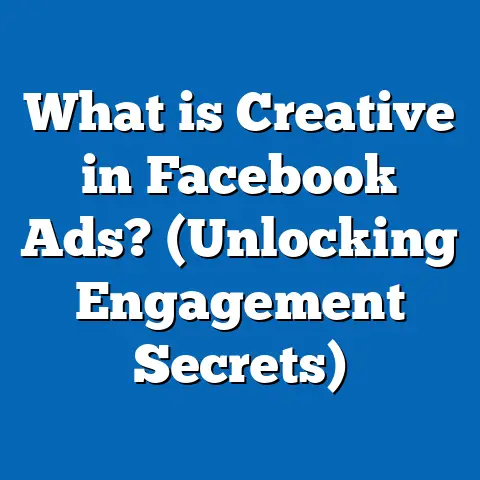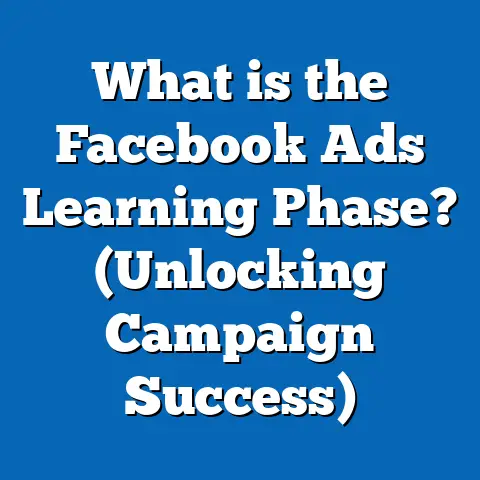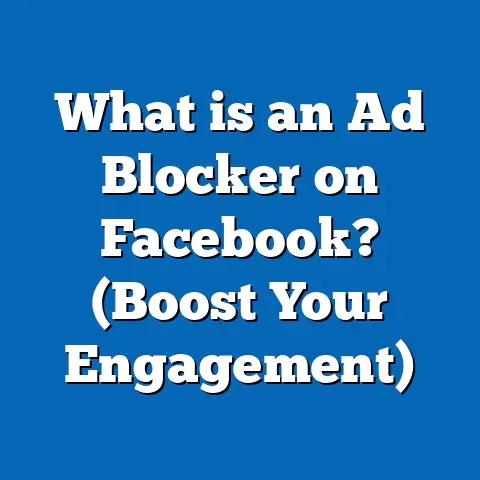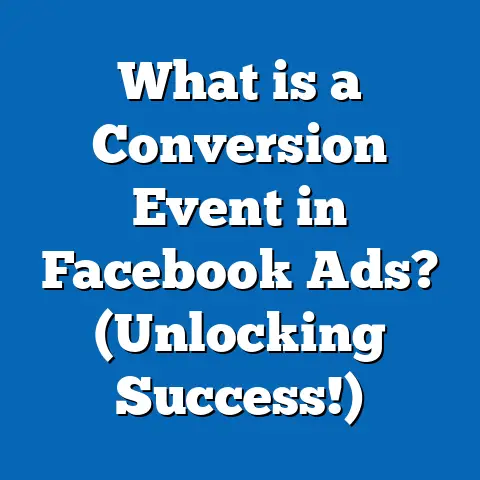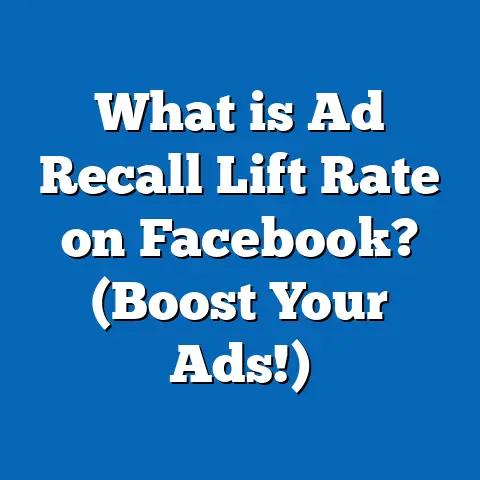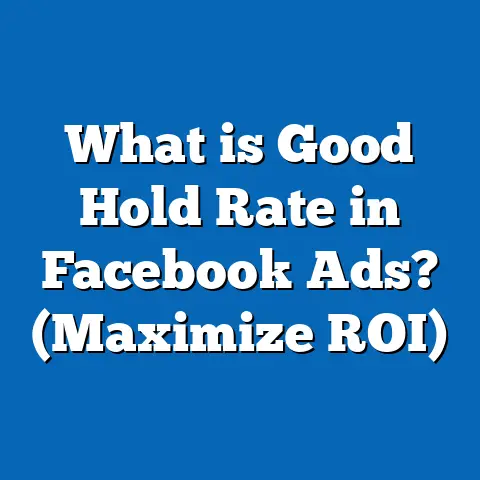What is a Good ROI for Facebook Ads? (Maximize Your Profits)
What if You Could Instantly Know the Exact ROI to Expect from Your Facebook Ads?
Imagine if every dollar you spent on Facebook advertising came back multiplied — not just covering costs but generating real profit. What if you had a clear benchmark to measure your campaigns’ success and maximize your returns? What if you could confidently scale your ad spend knowing your business would grow sustainably?
Understanding what defines a “good” ROI for Facebook ads is crucial to making informed decisions, optimizing budgets, and driving growth. Without this knowledge, marketers and business owners risk wasting money on campaigns that don’t deliver results.
This guide will walk you through everything you need to know about Facebook ads ROI — from basic definitions, industry benchmarks, data-driven insights, detailed case studies, and practical strategies to maximize your profits. Whether you’re a seasoned marketer or a business owner investing in social media advertising, this comprehensive resource is designed to help you unlock the full potential of your Facebook ad campaigns.
What Is ROI in Facebook Advertising?
Understanding Return on Investment (ROI)
Return on Investment (ROI) is the key metric that measures how profitable your Facebook ad campaign is relative to the amount of money you spent on it. It’s the percentage that tells you how much money you made (or lost) for every dollar invested in advertising.
ROI Formula: ROI=Revenue from Ads−Cost of AdsCost of Ads×100\text{ROI} = \frac{\text{Revenue from Ads} – \text{Cost of Ads}}{\text{Cost of Ads}} \times 100
For example, if you invest $500 into a Facebook campaign and generate $2,000 in sales directly attributed to those ads, your ROI is: 2000−500500×100=300%\frac{2000 – 500}{500} \times 100 = 300\%
This means a $1 investment returns $3 in revenue after covering the initial cost.
Gross Profit vs. Revenue: Which Should You Use?
Many marketers confuse revenue with profit. Revenue is the total sales generated, but gross profit accounts for the cost of goods sold (COGS) or service delivery expenses. For a true picture of profitability — and hence ROI — use gross profit instead of revenue.
- Revenue: Total amount customers pay
- Gross Profit: Revenue minus direct costs (e.g., product manufacturing, shipping)
If your revenue from Facebook ads is $2,000 but your COGS is $1,200, your gross profit is $800. The ROI calculation then becomes: 800−500500×100=60%\frac{800 – 500}{500} \times 100 = 60\%
This shows a more conservative and realistic view of profitability.
Why ROI Matters More Than Clicks or Impressions
Clicks and impressions are popular vanity metrics that indicate how many people saw or interacted with your ad. However, they don’t reveal whether those interactions converted into actual sales or leads.
ROI focuses on financial results, which are the ultimate goal of any marketing effort. High clicks with low conversions can drain your budget without adding value.
With Facebook’s advanced targeting and tracking tools, measuring ROI accurately has become easier than ever. It helps businesses:
- Optimize ad spend by focusing on profitable campaigns
- Justify marketing budgets with clear financial outcomes
- Identify high-performing audiences and creatives
- Avoid wasting money on ineffective ads
What Is a Good ROI for Facebook Ads? Industry Benchmarks and Insights
Determining what constitutes a “good” ROI depends heavily on your industry, business model, goals, and campaign objectives. There is no one-size-fits-all answer, but we can look at average benchmarks and data-backed insights to set realistic expectations.
Average ROI Benchmarks by Industry
Multiple sources including WordStream’s benchmark reports and AdEspresso’s aggregated data provide insights into average Facebook ad ROIs across industries:
| Industry | Average Facebook Ads ROI | Notes |
|---|---|---|
| E-commerce | 200% – 400% | Direct sales tracking helps accuracy |
| B2B | 130% – 300% | Longer sales cycles; focus on lead gen |
| Retail | 150% – 300% | Seasonal fluctuations affect results |
| Real Estate | 100% – 200% | High-ticket sales; slower conversions |
| Education | 120% – 250% | Often relies on lead nurturing |
| Health & Fitness | 180% – 350% | High customer repeat rate boosts ROI |
| Travel & Hospitality | 150% – 300% | Seasonality impacts ROIs |
These figures show that a good ROI typically ranges from 100% to 400%, meaning for every $1 spent, you earn $1 to $4 back in profit. If your ROI is above 100%, you’re making more than you spend — a baseline for profitability.
Case-Specific Variations
Small Businesses vs Enterprises
Small businesses may accept lower ROIs initially as they build brand awareness and customer loyalty. Enterprises with bigger budgets often aim for higher ROIs due to scale and efficiency.
Campaign Objectives Matter
Awareness campaigns prioritize reach over direct sales and may show lower immediate ROI but increase long-term brand value. Conversion campaigns are expected to have higher measurable ROIs.
The Latest Trends Affecting Facebook Ads ROI (2024)
Facebook advertising dynamics change rapidly due to platform updates, privacy regulations, and evolving user behavior. Staying ahead of these trends is essential to maintaining or improving ROI.
Privacy Changes and Data Limitations
Apple’s iOS 14+ updates requiring app tracking transparency have reduced the accuracy of conversion tracking for many advertisers. This forces businesses to rely on aggregated data and adjust attribution windows.
Facebook responded by enhancing its Conversions API to collect server-side data directly from advertisers’ websites, improving tracking reliability.
AI-Powered Optimization
Facebook’s machine learning algorithms have become more sophisticated at optimizing ad delivery based on user behavior patterns. Advertisers who leverage these tools see improved ROIs without manual intervention.
The Rise of Video Ads
Video content dominates engagement rates on social media. Facebook reports video ads can increase conversion rates by up to 20-30%, significantly boosting ROI when used effectively.
Dynamic Product Ads and Personalization
Personalized ads showing products based on user browsing behavior can increase conversion rates by up to 30%. Retargeting users with dynamic ads remains one of the highest ROI tactics.
How to Calculate ROI for Facebook Ads: Step-by-Step Guide
Calculating ROI accurately requires careful tracking of costs and revenues attributed to your campaigns.
Step 1: Track Your Ad Spend Accurately
Use Facebook Ads Manager to monitor exact costs per campaign, ad set, and individual ad level. Track daily spend and total investment for precise calculations.
Step 2: Measure Revenue Attributed to Facebook Ads
Set up Facebook Pixel or Conversions API on your website or app to track sales originating from your ads. Use URL parameters and UTM tags for added Google Analytics tracking.
Step 3: Calculate Gross Profit from Sales
Subtract direct costs associated with fulfilling orders or services from total revenue generated by the ads.
Step 4: Apply the ROI Formula
Use: ROI=Gross Profit−Ad SpendAd Spend×100\text{ROI} = \frac{\text{Gross Profit} – \text{Ad Spend}}{\text{Ad Spend}} \times 100
Step 5: Adjust for Attribution Windows
Consider Facebook’s attribution settings (default is “7-day click and 1-day view”) which influence how conversions are credited. Adjust expectations accordingly.
Tools to Simplify ROI Tracking and Reporting
Facebook Ads Manager
Google Analytics
Allows cross-channel attribution analysis and deeper funnel insights using UTM parameters.
Third-Party Platforms
- AdEspresso: Simplifies A/B testing and reporting
- HubSpot: Integrates CRM data with ad performance for lead-to-sale tracking
- Supermetrics: Aggregates data from multiple platforms into spreadsheets or BI tools
Leveraging these tools helps marketers make data-driven decisions that improve campaign profitability.
Case Studies: Real-World Examples of Facebook Ads ROI
Case Study 1: E-commerce Brand Boosting ROI by 300%
A mid-sized online fashion retailer ran video ad campaigns targeting lookalike audiences based on high-value past purchasers. They focused on dynamic product ads showcasing personalized items based on user behavior.
- Campaign cost: $20,000
- Revenue generated: $80,000
- Gross profit margin: 50%
ROI calculation: Gross Profit=80,000×0.5=40,000\text{Gross Profit} = 80,000 \times 0.5 = 40,000 ROI=40,000−20,00020,000×100=100%\text{ROI} = \frac{40,000 – 20,000}{20,000} \times 100 = 100\%
They doubled their investment by focusing on audience refinement and creative personalization.
Case Study 2: SaaS Company Achieving 150% ROI with Lead Gen Ads
A SaaS company running lead generation ads targeted specific industries using LinkedIn + Facebook retargeting combined with email nurture sequences.
- Ad spend: $10,000
- Revenue from converted leads: $25,000
- Gross profit margin: 60%
ROI calculation: Gross Profit=25,000×0.6=15,000\text{Gross Profit} = 25,000 \times 0.6 = 15,000 ROI=15,000−10,00010,000×100=50%\text{ROI} = \frac{15,000 – 10,000}{10,000} \times 100 = 50\%
Despite a longer sales cycle typical in SaaS, the campaign was profitable due to strategic nurturing.
Case Study 3: Local Retailer Increasing ROI from Negative to Positive
A local retailer initially ran broad targeting ads resulting in $5,000 spend but only $3,000 revenue directly attributed. After shifting to geo-targeted ads focusing on loyal customers with promotional offers:
- New spend: $3,000
- Revenue generated: $9,000
- Gross profit margin: 40%
ROI calculation: Gross Profit=9,000×0.4=3,600\text{Gross Profit} = 9,000 \times 0.4 = 3,600 ROI=3,600−3,0003,000×100=20%\text{ROI} = \frac{3,600 – 3,000}{3,000} \times 100 = 20\%
This modest positive ROI was a huge improvement from previous losses achieved by better targeting and personalized messaging.
Key Metrics That Impact Facebook Ads ROI
Understanding these metrics helps diagnose performance issues and optimize campaigns effectively.
Cost Per Acquisition (CPA)
CPA measures how much it costs to get one paying customer through your ads. Lower CPA generally leads to higher ROI.
Example: If your CPA is $50 but each new customer generates $200 in gross profit, your ROI will be positive.
Click-Through Rate (CTR)
CTR shows how many people clicked your ad after seeing it. Higher CTR usually signals relevant ads that attract clicks but doesn’t guarantee sales conversion.
Benchmark: Average CTR across industries is roughly between 0.9% – 1.6%.
Conversion Rate
The percentage of users who complete a desired action (purchase, sign-up) after clicking an ad. Improving conversion rate has a massive effect on ROI.
Customer Lifetime Value (CLV)
CLV estimates total revenue a customer will generate over their relationship with your business. Higher CLV allows higher CPA while maintaining positive ROI.
Strategies to Maximize Your Facebook Ads ROI
Maximizing ROI involves combining tactical improvements with strategic planning:
1. Refine Audience Targeting Using Data Insights
Use Facebook’s Custom Audiences created from:
- Website visitors tracked by Pixel
- Customer email lists
- Lookalike audiences modeled after top customers
Precision targeting increases relevance and conversion rates.
2. Optimize Ad Creatives Continuously Through Testing
Run A/B tests on different variables including:
- Headlines
- Images vs videos
- Calls-to-action (CTAs)
- Ad copy tone
Measure which versions yield the lowest CPA and highest conversion rates.
3. Leverage Retargeting Campaigns Effectively
Retarget users who:
- Visited product pages but didn’t purchase
- Added items to cart but abandoned checkout
- Engaged with previous ads but didn’t convert
Personalized retargeting often delivers some of the highest ROIs because it targets warm audiences closer to buying decisions.
4. Align Campaign Objectives Precisely With Business Goals
Choose the right objective in Ads Manager:
- Conversions: Best for direct sales or sign-ups
- Lead Generation: To capture contact info for later nurturing
- Traffic: Drive visitors who may convert later
- Brand Awareness: Helpful early-stage but less immediate ROI
Matching objective avoids misaligned results that hurt reported profitability.
5. Use Automated Rules and Budget Optimization Tools
Set rules to:
- Pause underperforming ads automatically
- Increase budgets incrementally on winning campaigns
- Adjust bids based on performance thresholds
Automation saves time and keeps campaigns focused on profitability.
6. Incorporate Engaging Video Content Regularly
Videos increase engagement rates significantly — often leading to better conversion rates than static images or text ads. Test short-form videos highlighting product benefits or customer testimonials.
7. Monitor Ad Frequency & Avoid Fatigue
When users see the same ad too many times (frequency >3), engagement drops leading to wasted spend. Rotate creatives often and expand target audiences if frequency rises too high.
Comparing Facebook Ads ROI with Other Advertising Platforms
Understanding how Facebook compares helps allocate budgets effectively across channels:
| Platform | Average ROI Range | Strengths | Considerations |
|---|---|---|---|
| 100% – 400% | Precise micro-targeting; diverse ad formats | Privacy changes impact tracking | |
| Google Ads | 150% – 350% | Intent-driven search traffic; high purchase intent | Generally higher CPC |
| Similar to Facebook | Visual-first platform; younger demographics | Needs strong creatives | |
| 50% – 200% | B2B targeting; professional audience | Higher CPC; smaller reach | |
| TikTok | Emerging data | Viral content potential; younger audience | Attribution still developing |
Facebook stands out for its balance of scale, targeting precision, and relatively affordable CPCs compared to other platforms when campaigns are well optimized.
Advanced Concepts: Attribution Models and Their Effect on ROI Measurement
Understanding attribution models clarifies how conversions are credited across touchpoints in customer journeys:
Last-click Attribution
Gives credit solely to the last interaction before purchase. Simple but underestimates earlier steps like brand awareness or retargeting efforts.
Multi-touch Attribution
Divides credit among multiple interactions in the conversion funnel — providing a more holistic view of campaign contributions.
Data-driven Attribution
Uses machine learning algorithms analyzing user paths across channels and assigns credit based on actual influence patterns — most accurate but requires extensive data volumes.
Practical Example: Calculating & Improving Your Own Facebook Ads ROI
- Gather Data: Collect total ad spend and revenue from Facebook Ads Manager + sales platform reports.
- Calculate Current ROI: Use gross profit for accuracy.
- Identify Weak Points: Review CPA, CTR, & conversion rates per campaign.
- Test Improvements: Change targeting or creative; run controlled A/B tests.
- Scale Winning Campaigns: Increase budgets cautiously while monitoring diminishing returns.
- Adjust Attribution Settings: Understand how conversion windows affect reported performance.
- Leverage Automation: Use rules for budget optimization.
- Track CLV: Factor in customer longevity when evaluating acquisition costs.
- Regularly Update Creatives: Prevent fatigue by refreshing ads every few weeks.
- Expand Retargeting: Capture lost opportunities with personalized follow-ups.
Additional Tips From Industry Experts
- Use video testimonials over static images — proven to boost trust and conversions.
- Segment audiences finely rather than broad targeting; narrow groups convert better.
- Experiment with new features like Facebook Shops or Live Shopping events.
- Keep mobile users in mind; optimize landing pages for mobile speed.
- Integrate offline sales data where possible for omnichannel attribution accuracy.
- Invest in high-quality creatives — poor visuals drastically reduce CTR.
- Monitor competitor activity using tools like Ad Library for inspiration.
- Consider seasonality when setting expectations; holidays often improve ROIs.
- Regularly review Facebook policy changes impacting ad approvals or targeting rules.
- Collaborate closely between marketing & sales teams for aligned goals & reporting consistency.
Summary: What Is a Good ROI for Facebook Ads?
- A good ROI typically ranges from 100% up to around 400%, varying by industry, business size, and campaign goals.
- Use gross profit rather than just revenue for accurate profitability measurement.
- Regularly track key metrics such as CPA, CTR, conversion rate, and CLV.
- Employ Facebook’s tracking tools like Pixel & Conversions API alongside third-party analytics.
- Adapt campaign strategies continuously based on data insights.
- Utilize retargeting & video content as core tactics for boosting ROI.
- Understand attribution models to interpret results correctly.
- Compare performance against benchmarks but focus mainly on progressive improvement.
- Automate budget management using Facebook’s rules & optimization features.
- Stay current with platform changes impacting privacy & ad delivery.
Next Steps to Maximize Your Facebook Ads Profits
- Set crystal-clear campaign objectives aligned with overall business goals.
- Implement robust tracking setups such as Facebook Pixel or Conversions API immediately.
- Regularly calculate your actual ROI using gross profit figures.
- Identify underperforming ads & refine targeting & creatives through A/B testing.
- Leverage retargeting campaigns aggressively.
- Scale successful campaigns strategically while monitoring key metrics.
- Incorporate engaging video content frequently into your strategy.
- Automate campaign management via rules & budget allocation tools.
- Factor customer lifetime value into acquisition cost decisions.
- Stay updated with industry news & evolving best practices through trusted sources.
By mastering these principles and tactics comprehensively outlined here, you can confidently invest in Facebook advertising knowing exactly what good ROI looks like — helping you maximize profits and grow your business effectively over time.

